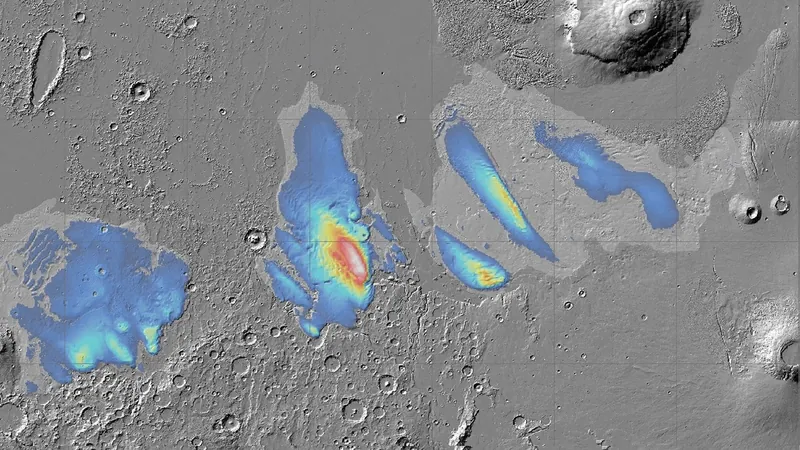
Unlocking the Secrets of Exotic Ice: How Infrared Technology Could Transform Our Understanding of Icy Moons
2025-09-11
Author: Jia
The Cosmic Role of Water Ice
Water ice is not just a simple molecule; it holds the key to understanding the intricate interiors and exteriors of many celestial bodies, from beloved Earth to distant moons and dwarf planets. Think about it—Pluto's icy plains and Europa's vast frozen fields are magnificent illustrate how ice shapes planetary landscapes, featuring everything from towering ice mountains to colossal ice volcanoes.
Diverse Ice Structures: The Mystery Unfolds
Under extreme conditions of pressure and temperature, ice can morph into various structural forms unlike anything found on our home planet. Unraveling these unique structures on moons like Ganymede could unlock secrets about their hidden geologies, much like studying Earth's mantle rocks reveals insights into our own planet's depths.
A New Approach to Ice Research
While researchers have typically used X-rays or neutron bombardment to study ice in labs, these methods aren’t feasible for space missions. Enter Christina Tonauer and her team from Universität Innsbruck in Austria, who suggest a revolutionary method: infrared spectroscopy. Their groundbreaking findings, recently published in 'Physical Review Letters', propose that we can utilize the powerful capabilities of the James Webb Space Telescope (JWST) and the European Space Agency's JUICE mission to analyze ice structures from afar.
From Lab to Cosmos: A Cosmic Connection
Tonauer, combining her passion for chemistry and astronomy, states, "The ices we create in the lab mirror those found in space." With JWST on the cusp of opening new avenues for deep-space exploration, her team focused on the shorter infrared wavelengths, promising a new era of ice analysis on distant worlds that earlier missions couldn’t access.
Ice Phases: More Than Meets the Eye
As of 2025, researchers have identified 21 distinct phases of ice—most of which are unfamiliar to us. The common form, ice Ih, has a specific hexagonal crystal arrangement. However, under the right extraterrestrial conditions, other ice forms could thrive. For instance, Ganymede might harbor ice structures akin to mantle dynamics found in the Earth, yet dominated by ice instead of silicate minerals.
Identifying Ice V and Ice XIII in Space
Tonauer's team specifically focused on ice V and ice XIII, which form under the extreme conditions found on moons like Ganymede. These types of ice possess identical oxygen atom arrangements but feature differing hydrogen configurations: disordered in ice V and structured in ice XIII. The remarkable part? By cooling water with liquid nitrogen and applying immense pressure, they successfully generated these exotic ice types in the lab.
A Glimpse Into Ganymede's Heart
What’s groundbreaking about this study is not just the formation of these ice types but their potential to persist even on lower-pressure surfaces like Ganymede's. This preservation could unveil new insights into the icy mantle beneath, enriching our understanding of the moon's internal structure. Previous missions hinted at a liquid water ocean trapped between layers of ice, but the nature of these icy layers has yet to be confirmed.
Remote Analysis: A Game Changer for Cosmic Exploration
This cutting-edge technique allows scientists to differentiate between the various ice phases without the hefty expense of returning samples to Earth. By employing infrared spectroscopy, researchers can validate or challenge existing models of icy moons' internal dynamics. As astrophysicist Danna Qasim highlights, such advancements are crucial in deciphering the complex structures of these stunningly beautiful worlds.
The Future of Ice Research in Space
While challenges remain—like analyzing mixed ice types containing amorphous forms—the potential of this method brings renewed hope for unraveling the mysteries of icy moons. With massive investments in space missions, it’s imperative to leverage laboratory breakthroughs like Tonauer's to truly comprehend the cosmos. The quest to understand the ice of distant worlds continues—a captivating endeavor lying at the very heart of planetary science.



 Brasil (PT)
Brasil (PT)
 Canada (EN)
Canada (EN)
 Chile (ES)
Chile (ES)
 Česko (CS)
Česko (CS)
 대한민국 (KO)
대한민국 (KO)
 España (ES)
España (ES)
 France (FR)
France (FR)
 Hong Kong (EN)
Hong Kong (EN)
 Italia (IT)
Italia (IT)
 日本 (JA)
日本 (JA)
 Magyarország (HU)
Magyarország (HU)
 Norge (NO)
Norge (NO)
 Polska (PL)
Polska (PL)
 Schweiz (DE)
Schweiz (DE)
 Singapore (EN)
Singapore (EN)
 Sverige (SV)
Sverige (SV)
 Suomi (FI)
Suomi (FI)
 Türkiye (TR)
Türkiye (TR)
 الإمارات العربية المتحدة (AR)
الإمارات العربية المتحدة (AR)